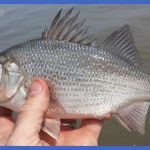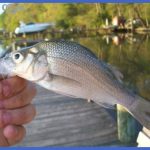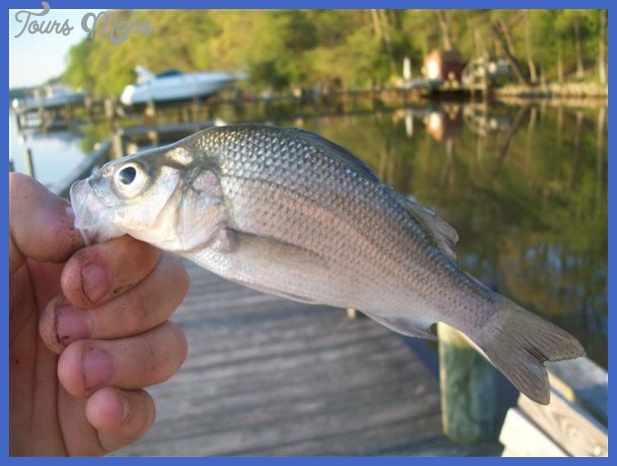White perch, Morone americana, are everybody’s fish. These scrappy panfish are closely related to striped bass and bear no relation to the perch family except in name. White perch are natives of brackish water, and their presence in Maine’s freshwater lakes, ponds, and streams can be attributed to a combination of of natural causes and private stocking efforts. The largest recorded white perch from Maine, a world record, was a 4.75 pound specimen measuring 19 inches.
White perch are a schooling species, with the schools segregated according to age groups. If you are catching small fish, all you need to do is search for a school of older, larger individuals.
White perch are aggressive feeders and are taken on flies, artificial lures, and bait. When taken on light tackle, white perch put up a fight that would do justice to any of the more famed species. Anglers used to taking these fish can tell immediately when they have hooked a white perch. Short but powerful runs, during which the fish bores toward the bottom, characterize the actions of white perch on the end of a line. In tenacity, white perch are equaled only by landlocked salmon and smallmouth bass.
White perch are present in such numbers that you can pretty much take as many fish as you can use without harming the fishery. Only a handful of waters have bag limits on white perch, and that is due to the insistence of local residents rather than any biological need for protection. In fact, the author has seen the average size of white perch increase after a pond was subjected to higher than average fishing pressure. Do take good care of your catch. Keep an ice-filled cooler on board and place your fish on ice as soon as possible. The result will be worth the effort. Maine law requires that all fish taken must be immediately released unharmed, or killed at once.
Maine people are fond of fish chowder, and the ultimate chowder uses white perch as the primary ingredient. The meat is flaky but firm, and sweet and delicate. When skinned and filleted, rolled in flour or cornmeal, and fried, white perch become an epicurean delight. It is no wonder, then, that these easily caught fish are so prized by their followers.
Anybody can catch white perch, but not everybody can consistently catch the largest specimens. The following techniques will help you in that department.
Techniques
Spin fishing – Most anglers use light spinning gear when white perch fishing. Since these panfish rarely weigh more than 2 pounds, light tackle is needed to fully appreciate their exceptional performance. A 1-piece rod, tiny reel, and no more than 4-pound test line is the perfect white perch outfit. White perch are aggressive feeders and will strike any artificial lure that approximates the size of a natural forage fish.
Although white perch will hit small spinners and spoons, this is not the best way to take the most fish or the largest specimens. Vertical jigging, however, is a very effective method. Lures for this type of fishing include the metal jigs used in ice fishing and the many varieties of jig combinations consisting of weighted heads and plastic bodies. Use lightweight jigs for the best results. Although Maine does not have any walleyes, an angler from another state could use the same techniques used for walleyes to take white perch.
Serious white perch fishers rely on electronic fish finders to locate schools of perch. Once a school is located, all you need to do is drift over it and work the jig. It sometimes helps to add a bit of minnow or worm to the jig, but it is not necessary.
Fly casting – White perch tend to feed on the surface in the evening. Unfortunately, it is mostly the smaller perch that exhibit this behavior. Still, if you are fishing a body of water that has average specimens nearing 1 pound, this can be great sport.
In order to extract the uttermost enjoyment from catching white perch on flies, use the lightest rod you own. White perch are not leader shy and a 4-pound or even 6-pound test tippet will not put them off. Any fly reel will suffice, because even the largest white perch don’t make long runs.
Dry flies should approximate the size of any naturals on the water, but more clever deception is not needed, for these fish will readily take any pattern. If you have never taken white perch on dry flies, you may miss the first few strikes. White perch do not reject artificials as quickly as trout, plus they have rather small mouths. Count to one before you raise your rod to strike.
Some anglers enjoy trolling with streamers and bucktails so much that they insist on trolling for white perch. This is not the most effective method, but it is a good way to locate schools. Use a few size B.B. split shot ahead of your fly to ensure that it is down at least 10 feet. You will get more hits if you occasionally impart action to your fly. Twitch your rod; grab the line and give a sharp tug. This will stimulate interest in your offering.
In late summer and early fall, white perch give evidence of their saltwater genesis by congregating in immense schools and frantically thrashing the surface. This is not always indicative of a feeding frenzy, but they do feed when exhibiting this behavior. If you see herring gulls swarming in some distant cove, make for it as quickly as you can. The birds are attracted to the swarming fish and you can get in on the action too. Be careful about approaching too close, as this may cause the fish to sound.
Bait fishing – Anglers using bait usually take more and larger fish than those using artificials. Any type of light-action rod and reel will do, but ultralight spinning gear is preferred. Most anglers use earthworms or night crawlers. These old standbys are certainly effective. But to catch the largest perch possible, use live minnows.
The type of minnow doesn’t seem to matter, except that dace, small suckers, and banded killifish are more durable than gold or silver shiners. As you might expect, the larger the bait, the better chances of taking a large perch. Bait fish of about 2 inches in length are best. Be sure to change the water in your bait pail frequently, or your bait may die from lack of oxygen.
Using a size 6 hook, hook the bait through the membrane just behind the lips. This does not severely injure the bait and it also makes hooking a fish easier, because white perch tend to swallow bait fish head first. If you have a fish locator, you are ahead of the game, if not, try fishing in from 20 to 40 feet of water. White perch do not seem to care about cover, and prefer a flat, muddy bottom. Don’t use any terminal gear except your hook and a small split shot to keep the bait down near bottom.
Don’t cast your bait, since that will shorten its life. Just let it down alongside the boat. Once the bait is near bottom, gently raise and lower your rod tip. If you feel a bite, count to five and strike. Some anglers like to anchor as soon as they catch a few fish. It is possible to keep a school of perch around for some time, because other fish are attracted to the struggles of a hooked fish. Two anglers can work a school to good effect. Sometimes you will see several fish following the one on your line, a sure sign that you are fishing to a school.
You can use the wind to your advantage by drifting over a school. When the fish stop biting, go back to where you began and repeat the process.
Ice fishing – In winter, white perch can be found in 50 to 60 feet of water. If the lake or pond you are fishing is not that deep, just head for the deepest spot.
Most anglers use tip-ups, baited with live minnows, while others prefer to use a light jig rod. You might want to set out a few tip-ups and jig at the same time. Generally the tip-ups will produce the largest perch.
If you are certain that you are in a good area, do not despair if the fish do not bite immediately. White perch have definite feeding schedules and it is possible to go without a bite for several hours, only to have all your flags flying at once as if somebody turned on a switch.
White perch behavior is directly influenced by lunar phases. Again, this may be due to their brackish-water beginnings. During his 40-some years of white perch fishing, the author has become convinced that it is a waste of time to go fishing during a full moon. The closer the moon is to its new phase, the better the white perch fishing.
Best bets for Maine white perch: Millinocket Lake, Site 76; Cobbosseecontee Lake, Site 10; and Megunticook Lake, Site 26. These lakes are noted for large white perch, but they represent only a small percentage of the Maine lakes that can provide great white perch fishing.
Fishing: White Perch Photo Gallery
Maybe You Like Them Too
- The Best Cities To Visit in The World
- World’s 10 Best Places To Visit
- Coolest Countries in the World to Visit
- Travel to Santorini, Greece
- Map of Barbados – Holiday in Barbados




